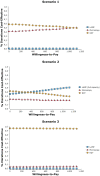Cost Effectiveness of New Diagnostic Tools for Cutaneous Leishmaniasis in Afghanistan
- PMID: 30465319
- PMCID: PMC6439180
- DOI: 10.1007/s40258-018-0449-8
Cost Effectiveness of New Diagnostic Tools for Cutaneous Leishmaniasis in Afghanistan
Abstract
Background and objectives: Cutaneous leishmaniasis is responsible for chronic and disfiguring skin lesions resulting in morbidity and social stigma. The gold standard to diagnose cutaneous leishmaniasis is microscopy but has a variable sensitivity and requires trained personnel. Using four scenarios, the objective of this study is to compare the cost effectiveness of microscopy with two new tools: Loopamp™ Leishmania Detection Kit (LAMP) and CL Detect™ Rapid Test (RDT).
Methods: Data related to the cost and accuracy of these tools were collected at the clinic of the National Malaria and Leishmaniasis Control Program in Kabul, Afghanistan. The effectiveness estimates were measured based on the tools' performance but also indirectly, using the disability-adjusted life years. A decision tree was designed in TreeAge Healthcare Pro 2016, combined with a Markov model representing the natural history of cutaneous leishmaniasis. In addition to a deterministic analysis, univariate sensitivity and probabilistic analyses were performed to test the robustness of the results.
Results: If the tools are compared at the National Malaria and Leishmaniasis Control Program level in a period of low incidence, microscopy remains the preferred option. LAMP becomes more appropriate during cutaneous leishmaniasis seasons or outbreaks when its capacity to process several tests (e.g. up to 48) at a time can be maximised. RDT has a cost similar to microscopy when used at the reference clinic but as it is relatively easy to use, it could be implemented at the peripheral level, which would become cheaper than employing microscopy at the reference clinic. Moreover, combining RDT with microscopy or LAMP at the reference clinic for the negative suspects is economically more interesting than directly performing LAMP or microscopy respectively on all cutaneous leishmaniasis suspects at the reference clinic.
Conclusions: When taking advantage of their respective strengths, LAMP and RDT can prove to be cost-effective alternatives to using microscopy alone at the reference clinic.
Conflict of interest statement
Conflict of Interest
Céline Aerts, Martijn Vink, Sayed Jalal Pashtoon, Sami Nahzat, Albert Picado, Israel Cruz and Elisa Sicuri have no conflicts of interest that are directly relevant to the contents of this article.
Ethics Approval
The study was carried out in accordance with the Helsinki Declaration, and approved by the Institutional Review Board of the National Public Health Institute, Ministry of Public Health, Islamic Republic of Afghanistan (Approval No. 361549).
Consent to Participate
The participants provided written informed consent in a one-on-one session with a member of the study. For illiterate individuals, the informed consent process was conducted in the presence of an impartial witness and for minors, the consent from a parent or guardian had to be obtained to be enrolled in the study.
Data Availability
The datasets generated during and/or analysed during the current study are available in the figshare repository at https://doi.org/10.6084/m9.figshare.6949043.
Figures









Similar articles
-
Evaluation of point-of-care tests for cutaneous leishmaniasis diagnosis in Kabul, Afghanistan.EBioMedicine. 2018 Nov;37:453-460. doi: 10.1016/j.ebiom.2018.10.063. Epub 2018 Nov 2. EBioMedicine. 2018. PMID: 30396855 Free PMC article. Clinical Trial.
-
Efficacy of a new rapid diagnostic test kit to diagnose Sri Lankan cutaneous leishmaniasis caused by Leishmania donovani.PLoS One. 2017 Nov 14;12(11):e0187024. doi: 10.1371/journal.pone.0187024. eCollection 2017. PLoS One. 2017. PMID: 29135995 Free PMC article.
-
Health economic evaluation of moist wound care in chronic cutaneous leishmaniasis ulcers in Afghanistan.Infect Dis Poverty. 2018 Feb 14;7(1):12. doi: 10.1186/s40249-018-0389-4. Infect Dis Poverty. 2018. PMID: 29444705 Free PMC article.
-
Test accuracy of polymerase chain reaction methods against conventional diagnostic techniques for Cutaneous Leishmaniasis (CL) in patients with clinical or epidemiological suspicion of CL: Systematic review and meta-analysis.PLoS Negl Trop Dis. 2020 Jan 21;14(1):e0007981. doi: 10.1371/journal.pntd.0007981. eCollection 2020 Jan. PLoS Negl Trop Dis. 2020. PMID: 31961871 Free PMC article.
-
Diagnosing Cutaneous leishmaniasis using Fluorescence in Situ Hybridization: the Sri Lankan Perspective.Pathog Glob Health. 2019 Jun;113(4):180-190. doi: 10.1080/20477724.2019.1650228. Epub 2019 Aug 20. Pathog Glob Health. 2019. PMID: 31429388 Free PMC article.
Cited by
-
Diagnosis of visceral and cutaneous leishmaniasis using loop-mediated isothermal amplification (LAMP) protocols: a systematic review and meta-analysis.Parasit Vectors. 2022 Jan 24;15(1):34. doi: 10.1186/s13071-021-05133-2. Parasit Vectors. 2022. PMID: 35073980 Free PMC article.
-
Glycosylated gold nanoparticles in point of care diagnostics: from aggregation to lateral flow.Chem Soc Rev. 2022 Aug 15;51(16):7238-7259. doi: 10.1039/d2cs00267a. Chem Soc Rev. 2022. PMID: 35894819 Free PMC article. Review.
-
Diagnostic performance of CL Detect rapid-immunochromatographic test for cutaneous leishmaniasis: a systematic review and meta-analysis.Syst Rev. 2023 Dec 20;12(1):240. doi: 10.1186/s13643-023-02422-y. Syst Rev. 2023. PMID: 38115138 Free PMC article.
-
Lateral Flow Glyco-Assays for the Rapid and Low-Cost Detection of Lectins-Polymeric Linkers and Particle Engineering Are Essential for Selectivity and Performance.Adv Healthc Mater. 2022 Feb;11(4):e2101784. doi: 10.1002/adhm.202101784. Epub 2021 Nov 17. Adv Healthc Mater. 2022. PMID: 34747143 Free PMC article.
-
Laboratory diagnostics for human Leishmania infections: a polymerase chain reaction-focussed review of detection and identification methods.Parasit Vectors. 2022 Nov 5;15(1):412. doi: 10.1186/s13071-022-05524-z. Parasit Vectors. 2022. PMID: 36335408 Free PMC article. Review.
References
-
- World Health Organization. Leishmaniasis: the disease. Geneva: World Health Organization;.
-
- World Health Organization . Manual for case management of cutaneous leishmaniasis in the WHO Eastern Mediterranean Region. Geneva: World Health Organization; 2014.
-
- World Health Organization . Weekly epidemiological record. Geneva: World Health Organization; 2016.

